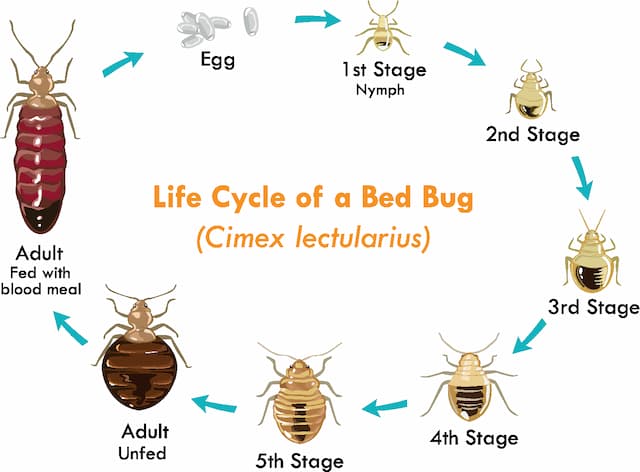Bed bugs, the tiny bugs that come out at night and bother us while we sleep, are becoming more of a problem for people who live in their homes and travel. To get rid of these bloodsucking bugs effectively, you need to know how they live. To both stop them and get rid of them, you need to know how they grow and what habits they have. This article will talk about the different stages of a bed bug’s life and how knowing about these stages can help you get rid of these annoying bugs.
- The egg stage: Bed bugs start their lives as eggs. The female bed bugs lay these tiny, white, sticky eggs in cracks and crevices, often close to the people they live with. Over the course of her life, a female can lay hundreds of eggs. Most of the time, the eggs hatch in 6 to 10 days.
- The Nymph Stages: Bed bugs go through the nymph stage after they hatch. Nymphs are very small, about the size of a pinhead, and almost see-through. To moult and grow, they need to eat blood meals every so often. There are five steps that bed bugs go through as nymphs. Each stage makes them bigger and darker. These are the steps that bed bugs go through before becoming adults.
- The adult stage: A bed bug is an adult once it has grown past the nymph stage. The adults of bed bugs are about the size of an apple seed and are a burnt red colour. It looks like a circle and is flattened. At this point, they are ready to have babies and feed on blood. Bed bugs can live for a few months to more than a year, based on their surroundings.
- Getting food and mating: Bed bugs that are adults feed on blood, and they are most busy at night. They find their hosts by picking up on the heat and carbon dioxide we give off. A bed bug gets fat after eating, and its body swells up and goes red. Bed bugs often mate after they have eaten, and both male and female bugs take part. Bed bugs that are female can lay eggs after just one mating, and they can do this their whole lives.
- Length of life and reproduction: How long a bed bug lives relies on things like temperature, where it can hide, and where it can eat. People who live in warmer places and have easy access to food can grow faster and live longer. A bed bug can live its whole life cycle in as little as one month if everything is perfect. However, cooler temps and limited access to food can make the lifecycle last a lot longer.
- Where to hide and how to act: Bed bugs know how to hide and stay alive. During the day, they like to hide in cracks, gaps, and dark places, which makes them hard to find. Mattress seams, furniture joints, behind baseboards, and electrical plugs are all common places to hide. They are drawn to the smell of other bugs, which is why swarms can spread so quickly.
- How they eat: Bed bugs are insects that feed on blood. They usually eat on skin that is exposed, usually at night. Their bites don’t hurt much, but they can leave red, itching welts on the skin. Bed bugs can have a big effect on your mental health, causing stress, trouble sleeping, and even fear.
In conclusion
To effectively control and avoid bed bugs, you need to know how they live and reproduce. You can better focus your efforts to get rid of these persistent pests if you know the stages they go through. You can get these quiet invaders out of your home quickly by doing things like vacuuming, deep cleaning, and calling a pest control service.
Guaranteed, effective, and reliable bed bug control treatment in Bolton. Done by fully licensed and insured professionals. We take full control of your bed bug infestation and put an end to it using successful methods through chemical and heat treatments.Call now and book a treatment: 647-578-7949.
